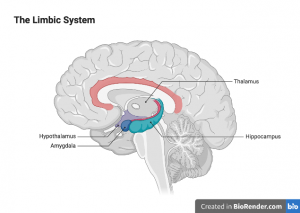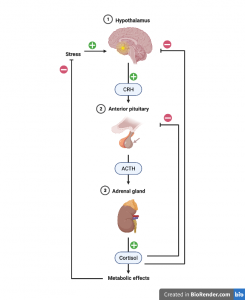1.6 Possible Developmental Effects of Childhood Maltreatment
Courtney Schumph
LEARNING OBJECTIVES
To understand how neurobiological systems are negatively impacted by childhood maltreatment. By the end of this section, you should be able to:
- Understand the basics of normal brain development
- Identify neural systems that are important for psychological well-being
- Understand the biological, mental, emotional, and behavioural impacts of maltreatment
Normal Brain Development
Intracranial volume, or the space within the cranium housing the brain, meninges, and cerebral spinal fluid (CSF), increases until 10 years of age. The majority of this growth, however, occurs much earlier. Approximately 75% of volume increase occurs by 2 years of age and by 5 years is almost completed (De Bellis et al., 1999). Brain development begins in-utero, with the overproduction of neurons. Once born, the infant’s brain undergoes selective elimination of neurons until approximately 4 years of age (De Bellis et al., 1999).
From 5-18 years of age, brain development is largely influenced by a process known as myelination (De Bellis et al., 1999). The myelination process is influenced strongly by both biological and environmental factors, including genetics, growth factors, stress, trauma, and socioeconomic status (De Bellis et al., 1999).
With age, neurons tend to grow in size. This can be observed by the thickening of axons, as well as an increase in the number of axon terminals (De Bellis et al., 1999).
Important Systems
In this section, we will be looking at the role of the prefrontal cortex, the limbic system, the hypothalamic-pituitary-adrenal (HPA) axis, the brain reward system, and oxytocin in relation to child maltreatment. Before we begin, a basic understanding of each of these biological components is required.
The Prefrontal Cortex
The prefrontal cortex is located at the forwardmost position of the frontal lobe and is involved in planning complex cognitive behaviour, decision-making, and moderating social behaviour (The Science of Psychotherapy, 2017). This is what supports concrete learning, and where future consequences are contemplated. The prefrontal cortex is necessary for interpreting reality and plays a large role in an individual’s personality (The Science of Psychotherapy, 2017). There are three areas to the prefrontal cortex: the dorsolateral prefrontal cortex (DLPFC), the orbitofrontal cortex (OFC), and the ventromedial prefrontal cortex (vmPFC).
The dorsolateral prefrontal cortex (DLPFC) is the topmost part of the prefrontal cortex. It is responsible for the overall management of cognitive processes, such as planning and working memory, and connects with the hippocampus for retrieval and consolidation of long-term explicit memories (The Science of Psychotherapy, 2017).
The orbitofrontal cortex (OFC) is responsible for the cognitive processing of decision-making, as well as the integration of external sensory information with internal emotional information. It forms a close connection with the limbic system to allow for decision-making on the basis of emotional information. It also allows for an individual to interpret social interactions and modulate behaviour based on potential reactions from others (The Science of Psychotherapy, 2017).
The ventromedial prefrontal cortex (vmPFC) is responsible for gathering information from other areas of the brain to make decisions, such as the amygdala, temporal lobe, and olfactory system. It mediates decision-making with the integration of emotional information and regulates feelings during social interactions. This area of the brain is associated with feelings of courage, compassion, and the suppression of negative emotions (The Science of Psychotherapy, 2017).
The Limbic System
The limbic system is a neural pathway that is involved with emotional and behavioural responses (Queensland Brain Institute, 2019). Although there are several structures that comprise the limbic system (see Figure 1 below), there are two we will focus on: the hippocampus and the amygdala.
The hippocampus is integral for learning new things. It plays a role in the formation of episodic memories and associations between various senses and memories. The amygdala generates emotional responses, such as pleasure, fear, and anger. It is responsible for associations between memories and emotions, as well as the formation of new memories out of strong feelings of fear (Queensland Brain Institute, 2019).

The Hypothalamic-Pituitary-Adrenal Axis
The hypothalamic-pituitary-adrenal (HPA) axis serves as a biological stress system (De Bellis, 1999). It functions to respond to external stressors by utilizing three major structures: the hypothalamus, the pituitary gland, and the adrenal glands (Chrousos, 2009).

In response to a perceived threat, the adrenal glands secrete two hormones: epinephrine and norepinephrine. These hormones travel to the bloodstream and are then detected by the hypothalamus. In response, the hypothalamus secretes corticotropin-releasing hormone (CRH; also known as corticotropin-releasing factor, or CRF) to activate the pituitary gland. The pituitary gland (specifically the anterior pituitary) then secretes adrenocorticotropic hormone (ACTH) to increase the activity of the sympathetic nervous system (responsible for activating a “fight or flight” response). This activation then stimulates the outer layer of the adrenal glands, known as the adrenal cortex, to cause the secretion of glucocorticoids, such as cortisol (Chrousos, 2009).
Cortisol is a compound of interest when studying stress responses, as it can be easily detected in urine. We call this cortisol “urinary free cortisol”(UFC). By analyzing the concentration of UFC in urine, we can gauge the current activity of the body’s sympathetic nervous system (De Bellis et al., 1999).
The Brain Reward System
The brain reward system serves to process rewards and motivate behaviours through dopamine, a neurotransmitter. It assists the hippocampus by strengthening its synapses, enhancing reward-related memories. It also is able to create emotional associations with rewards through signalling in both the amygdala and prefrontal cortex. This is what allows for the reinforcement of behaviours through reward and prevents behaviours that would result in punishment (Society for Neuroscience, 2018).
Oxytocin
Oxytocin is a hormone produced by the hypothalamus and secreted by the pituitary gland. Although often associated with biological processes such as childbirth, it also influences learning, memory, and social information processing. Increases in oxytocin are associated with increasing prosocial behaviours (behaviours that positively impact others). It also helps to regulate the balance between the amygdala and prefrontal cortex during social interactions (Shamay-Tsoory & Young, 2016).
Possible Developmental Effects
One developmental consequence of childhood maltreatment is an increased sensitivity or hypervigilance to perceived threats. Individuals tend to be more aware of anger following maltreatment, particularly those who are victims of physical abuse. This suggests alterations to the limbic system, such as heightened amygdala reactivity, as well as altered prefrontal cortex circuitry (Kisley et al., 2020).
Maltreated children may also have difficulty recognizing and responding appropriately to the emotions of others and themselves (Kisley et al., 2020). In turn, this may increase the likelihood of rejection by peers and further hindrance of neurobiological development. A potential cause of this difficulty could be alterations to the prefrontal cortex, as previous studies have noted personality changes and a reduced ability to orient behaviour in individuals suffering from cortical damage (The Science of Psychotherapy, 2017). These abnormalities could also be the result of alterations to the brain reward system. When the reward pathway is activated inappropriately in response to violent social stimuli, it may result in aggressive behaviours from the individual (Society for Neuroscience, 2018). Finally, abnormalities could be the result of alterations in the delivery and/or expression of oxytocin. Current research suggests that oxytocinergic treatments for social anxiety may be beneficial (Shamay-Tsoory & Young, 2016).
Alterations to the reward system, in particular, may increase the risk of depression in maltreated children. Because the reward system plays an integral role in promoting certain behaviours and feelings of well-being, a dysfunctional reward pathway could result in reward-based learning deficits and a general lack of positive, dopamine-mediated feelings. It is suggested that emotional abuse and neglect have the most detrimental effects on the reward and oxytocin systems (Kisley et al., 2020).
Childhood maltreatment, particularly emotional abuse and neglect, can have adverse effects on early-life neurobiological development. This can be observed as an accelerated loss of neurons, delays in myelination, and/or abnormalities in synaptic pruning (De Bellis et al., 1999). These abnormalities hold the potential for drastic setbacks to physical, cognitive, emotional, and social growth. In individuals suffering from diagnosed mental disorders, there is a significant reduction in prefrontal cortical cerebral volume (Kisley et al., 2020; The Science of Psychotherapy, 2017). A decreased volume suggests a decreased number of neural connections, hindering the ability of the prefrontal cortex to manage cognitive processes, moderate social behaviours, and regulate emotions.
Additionally, studies have provided evidence for the positive correlation between altered biological stress systems and children suffering from post-traumatic stress disorder (PTSD). Children suffering from PTSD show significant increases in urinary free cortisol concentrations, suggesting that their HPA axis is activated in times when there is an absence of threat (De Bellis et al., 1999).
KEY TERMS
- Prefrontal Cortex: located at the forwardmost position of the frontal lobe; comprised of the dorsolateral prefrontal cortex (DLPFC), the orbitofrontal cortex (OFC), and the ventromedial prefrontal cortex (vmPFC). Responsible for planning complex cognitive behaviour, decision-making, and moderating social behaviour.
- Limbic System: a neural pathway involved in emotional and behavioural responses; major structures include the amygdala and hippocampus.
- Hippocampus: a seahorse-shaped structure located in the temporal lobe; involved in learning and memory
- Amygdala: a structure located in the temporal lobe; involved emotional responses and memory
- Biological stress system: a hormonal pathway that services to increase the activity of the sympathetic nervous system (SNS) in response to a perceived threat.
- Adrenal glands: located above the kidneys; secretes epinephrine, norepinephrine, and glucocorticoids (such as cortisol) in response to stressors.
- Hypothalamus: a structure located in the brainstem involved in biological stress systems; detects epinephrine and norepinephrine in the bloodstream, secretes corticotropin-releasing hormone (CRH) in response, activating the pituitary gland.
- Pituitary gland: a structure located in the brainstem involved in biological stress systems; detects CRH and secretes adrenocorticotropic hormone (ACTH) in response.
- Sympathetic nervous system (SNS): refers to components of the nervous system that function subconsciously and generate a stress response.
- Brain reward system: a neural pathway involved in reward processing and motivation; mediated by the neurotransmitter dopamine.
- Oxytocin: a hormone produced by the hypothalamus and secreted by the pituitary gland; involved in learning, memory, and social information processing
